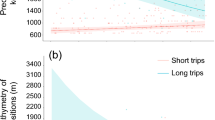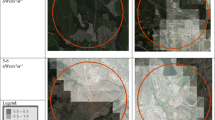Abstract
Feathers are used for flight, and any damage to feathers impairs efficient escape from predators. Because individuals can either rapidly produce feathers of poor quality or slowly produce feathers of high quality, prey experience a trade-off between speed of molt, quality of feathers, and risk of predation. We analyzed feathers produced by Woodpigeon Columba palumbus prey captured by Goshawks Accipiter gentilis and compared those to feathers shed during molt in the same areas. Feathers that were produced rapidly as reflected by long daily growth increments suffered from a greater degree of feather wear than feathers that were produced slowly. Prey had longer daily growth increments and a shorter period of molt than non-prey. Woodpigeons with worn feathers were more likely to fall prey to Goshawks than those with little or no wear to the plumage. These effects were independent of age, year, and time during the breeding season. These findings are consistent with a trade-off between speed of molt and feather quality affecting predation risk.
Zusammenfassung
Der Kompromiss zwischen schnellem Federwachstum und verminderter Federqualität erhöht das Prädationsrisiko.
Federn dienen dem Flug und jegliche Federschäden beeinträchtigen eine erfolgreiche Flucht vor Prädatoren. Da Individuen entweder schnell Federn minderer Qualität oder langsam Federn höherer Qualität bilden können, unterliegen Beutevögel einer Gratwanderung zwischen Mausergeschwindigkeit, Federqualität und Prädationsrisiko. Wir analysierten Federn von durch Habichte Accipiter gentilis erbeuteten Ringeltauben Columba palumbus und verglichen diese mit Mauserfedern aus denselben Gebieten. Schnell gewachsene Federn, erkennbar an breiten täglichen Wachstumsstreifen, unterlagen einem stärkeren Abnutzungsgrad als Federn, die langsam gewachsen waren. Erbeutete Vögel hatten breitere tägliche Wachstumsstreifen und einen kürzeren Mauserzeitraum als nicht erbeutete Vögel. Ringeltauben mit abgenutzten Federn wurden mit größerer Wahrscheinlichkeit von Habichten erbeutet als solche mit wenig oder keiner Gefiederabnutzung. Diese Effekte traten unabhängig von Alter, Jahr und Brutzeitabschnitt auf. Diese Befunde stehen im Einklang mit einem Kompromiss zwischen Mausergeschwindigkeit und Federqualität, welcher das Prädationsrisiko beeinflusst.




Similar content being viewed by others
References
Becker WA (1984) Manual of quantitative genetics. Academic Enterprises, Pullman
Bensch S, Grahn M (1993) A new method for estimating individual speed of molt. Condor 95:305–315
Cramp S, Perrins CM (eds) (1985) The birds of the Western Palearctic, vol 4. Oxford University Press, Oxford
Crick HQP, Gibbons DW, Magrath RD (1993) Seasonal changes in clutch size in British birds. J Anim Ecol 62:263–273
Dawkins R, Krebs JR (1979) Arms races between and within species. Proc R Soc Lond B 205:489–511
Dawson A (2004) The effects of delaying the start of moult on the duration of moult, primary feather growth rates and feather mass in Common Starlings Sturnus vulgaris. Ibis 146:493–500
Dawson A, Hinsley SA, Ferns PN, Bonser RHC, Eccleston L (2000) Rate of moult affects feather quality: a mechanism linking current reproductive effort to future survival. Proc R Soc Lond B 267:2093–2098
de la Hera I, Schaper SV, Díaz JA, Pérez-Tris J, Bensch S, Tellería JL (2011) How much variation in the molt duration of passerines can be explained by the growth rate of tail feathers? Auk 128:321–329
Falconer DS, Mackay TFC (1996) Introduction to Quantitative Genetics, 4th edn. Longman, New York
Ginn HB, Melville DS (1983) Moult in birds. British Trust for Ornithology, Tring
Grubb TC Jr (1991) A deficient diet narrows growth bars on induced feathers. Auk 108:725–727
Grubb TC Jr (2006) Ptilochronology. Oxford University Press, New York
Grubb TC Jr, Yosef R (1992) Territory size influences nutritional condition in nonbreeding Loggerhead Shrikes (Lanius ludovicianus): a ptilochronology approach. Cons Biol 6:447–449
Grubb TC Jr, Yosef R (1994) Habitat-specific nutritional condition in Loggerhead Shrikes (Lanius ludovicianus): evidence from ptilochronology. Auk 111:756–759
Grubb TC Jr, Waite TA, Wiseman AJ (1991) Ptilochronology: induced feather growth in Northern Cardinals varies with age, sex, ambient temperature, and day length. Wilson Bull 103:435–445
Hall KSS, Fransson T (2000) Lesser Whitethroats under time-constraint moult more rapidly and grow shorter wing feathers. J Avian Biol 31:583–587
Haukioja E (1971) Flightlessness in some moulting passerines in Northern Europe. Ornis Fenn 48:101–116
Jenni L, Winkler R (1994) Moult and ageing of European passerines. Academic, London
Kenward R (2006) The goshawk. Poyser, London
Lustick S (1970) Energy requirements of molt in cowbirds. Auk 87:742–746
Mauck RA, Grubb TC Jr (1995) Petrel parents shunt all experimentally increased reproductive costs to their offspring. Anim Behav 49:999–1008
Møller AP, Nielsen JT (2007) Malaria and risk of predation: a comparative study of birds. Ecology 88:871–881
Møller AP, Couderc G, Nielsen JT (2009) Viability selection on prey morphology by a generalist predator. J Evol Biol 22:1234–1241
Møller AP, Flensted-Jensen E, Klarborg K, Mardal W, Nielsen JT (2010) Climate change affects the duration of the reproductive season in birds. J Anim Ecol 79:777–784
Møller AP, Peralta-Sánchez JM, Nielsen JT, López-Hernández E, Soler JJ (2012a) Goshawk prey have more bacteria than non-prey. J Anim Ecol 81:403–410
Møller AP, Solonen T, Byholm P, Huhta E, Nielsen JT, Tornberg R (2012b) Spatial consistency in susceptibility of prey species to predation by two Accipiter hawks. J Avian Biol 43:390–396
Payne RB (1972) Mechanism and control of molt. In: Farner DS, King JR (eds) Avian biology, vol 2. Academic. London, UK, pp 103–155
Pennycuick CJ (1975) Mechanics of flight. In: Farner DS, King R (eds) Avian biology, vol 5. Academic. London, UK, pp 1–75
Pennycuick CJ (2008) Modelling the flying bird. Academic, London
Perrins CM (1965) Population fluctuations and clutch-size in the Great Tit, Parus major. J Anim Ecol 34:601–647
Saino N, Romano M, Caprioli M, Ambrosini R, Rubolini D et al (2012) A ptilochronological study of carry-over effects of conditions during wintering on breeding performance in the barn swallow. J Avian Biol 43:513–524
Saino N, Romano M, Caprioli M, Lardelli R, Micheloni P, Scandolara C, Rubolini D, Fasola M (2013) Molt, feather growth rate and body condition of male and female Barn Swallows. J Ornithol 154:537–547
Saino N, Romano M, Rubolini D, Ambrosini R, Romano A, Caprioli M, Costanzo A, Bazzi G (2014) A trade-off between reproduction and feather growth in the Barn Swallow (Hirundo rustica). PLoS ONE 9(5):e96428
SAS (2012) JMP version 10.2. SAS Institute, Inc, Cary
Serra L (2001) Duration of primary moult affects primary quality in Grey Plovers Pluvialis squatarola. J Avian Biol 32:377–380
Stresemann E, Stresemann V (1966) Die Mauser der Vögel. J Ornithol Sonderheft 106:1–445
Takaki Y, Eguchi K, Nagata H (2001) The growth bars on tail feathers in the male Styan’s Grasshopper warbler may indicate quality. J Avian Biol 32:319–325
Vágási CI, Pap PL, Vincze O, Benkő Z, Marton A, Barta Z (2012) Haste makes waste but condition matters: molt rate–feather quality trade-off in a sedentary songbird. PLoS One 7:e40651
Waite TA (1990) Effect of caching supplemental food on induced feather regeneration in wintering Gray Jays Perisoreus canadensis: a ptilochronology study. Ornis Scand 21:122–128
Acknowledgements
We thank the landowners for access to the study sites. J. M. Neto, W. Cresswell and two anonymous referees provided constructive criticism.
Author information
Authors and Affiliations
Corresponding author
Additional information
Communicated by O. Krüger.
Rights and permissions
About this article
Cite this article
Møller, A.P., Nielsen, J.T. The trade-off between rapid feather growth and impaired feather quality increases risk of predation. J Ornithol 159, 165–171 (2018). https://doi.org/10.1007/s10336-017-1483-2
Received:
Revised:
Accepted:
Published:
Issue Date:
DOI: https://doi.org/10.1007/s10336-017-1483-2




